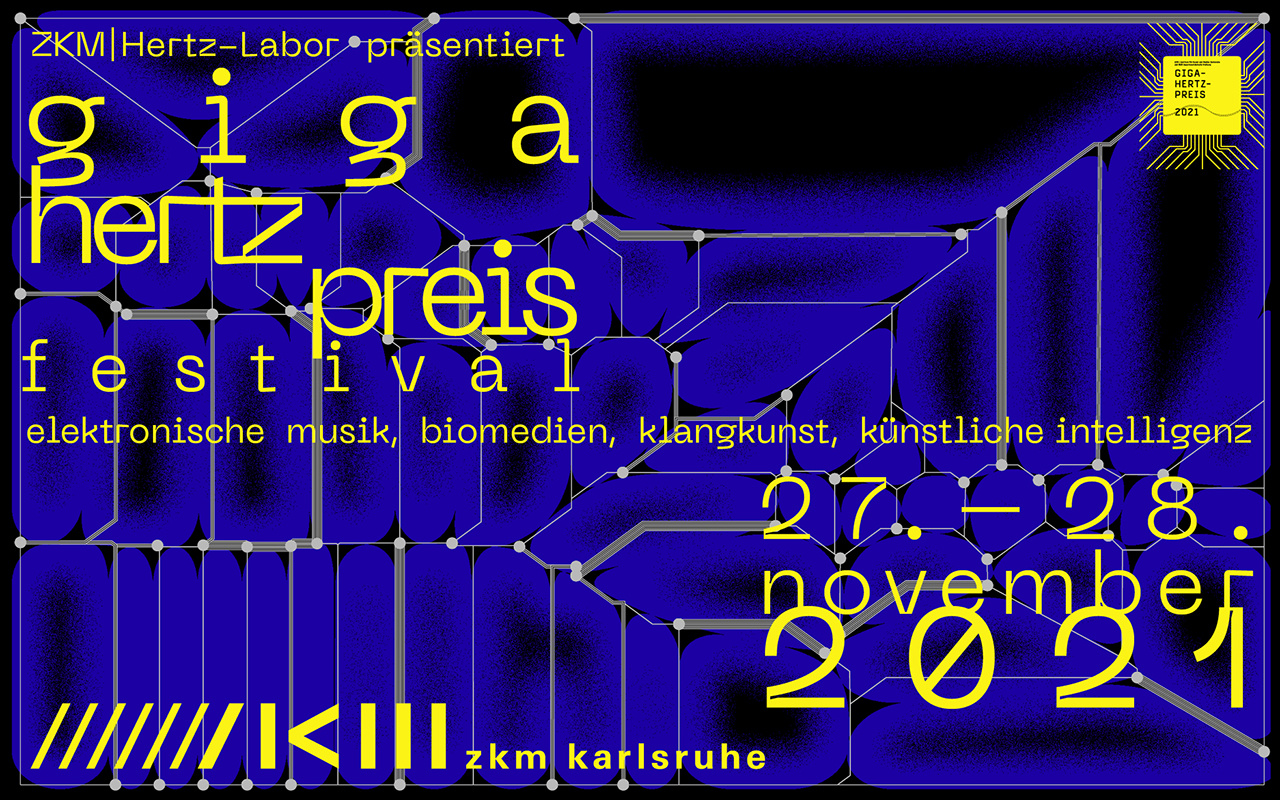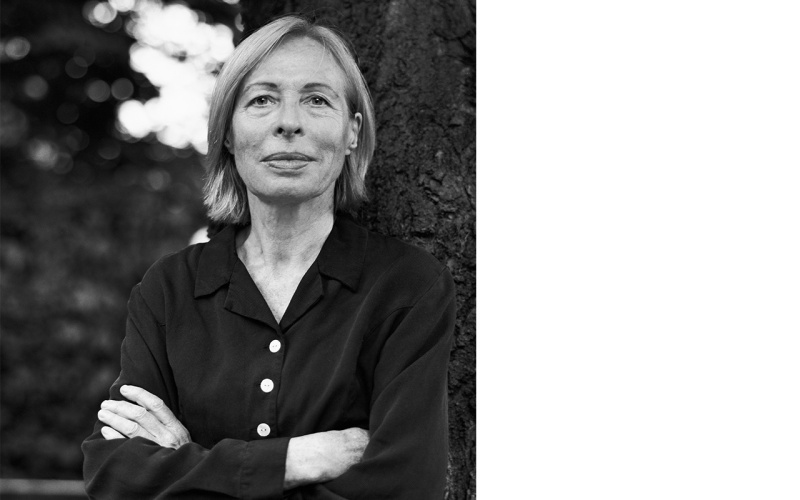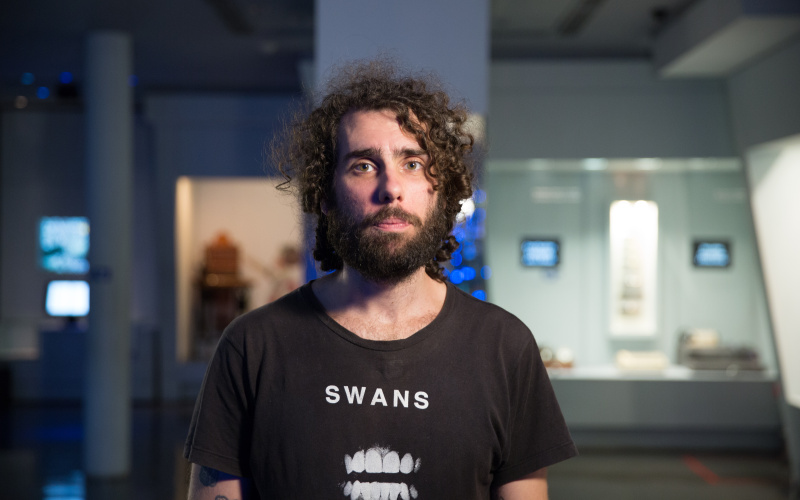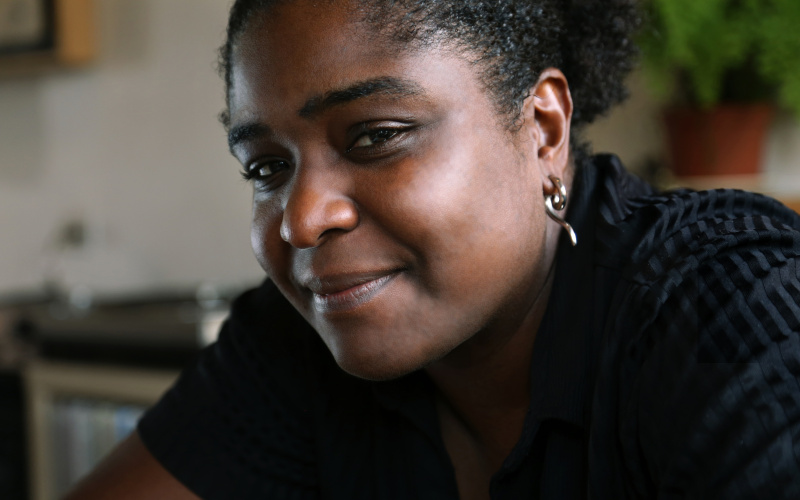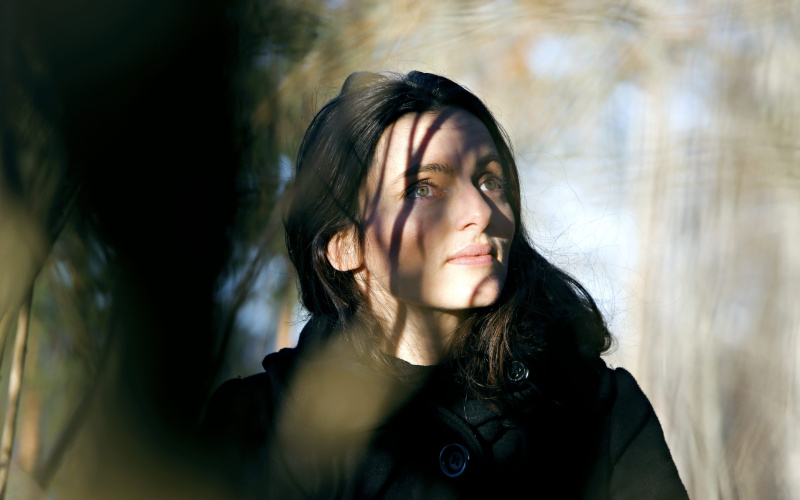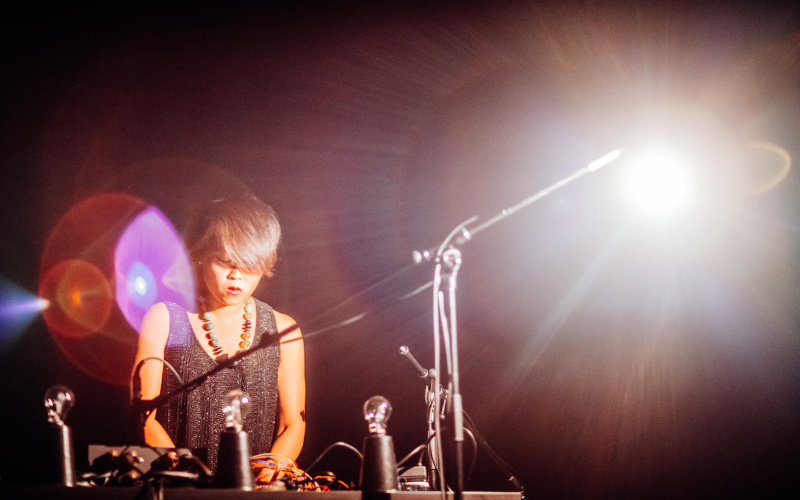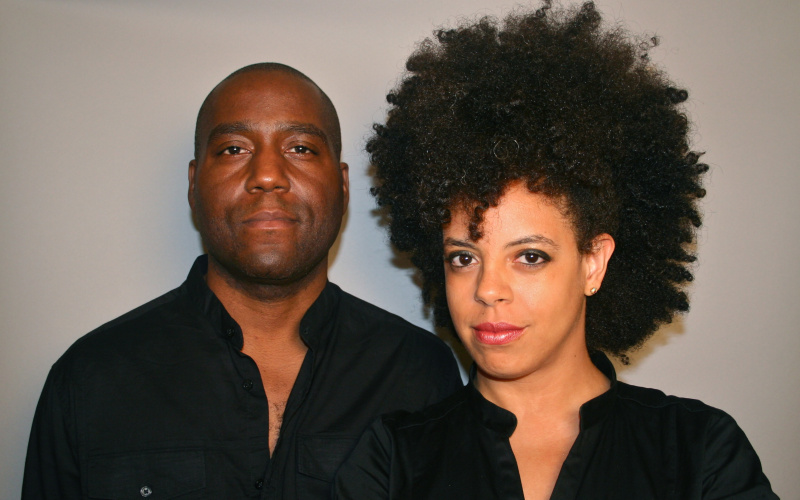Giga-Hertz Award 2021
Festival for Electronic Music
Sat, November 27 – Sun, November 28, 2021
- Location
- Online
- Language
- English
The Giga-Hertz Award for Electronic Music has been awarded since 2007 by ZKM | Karlsruhe and SWR Experimentalstudio. This year’s artists and composers will be honored during a two-day festival.
Together with the SWR Experimental Studio, the ZKM | Centre for Art and Media annually awards the Giga-Hertz Award for Electronic Music. The 2021 award winner is sound artist Christina Kubisch, who receives the main award of 10,000 euros for her pioneering life's work. The Giga-Hertz Production Awards go to Yvette Janine Jackson from the USA and André Damião from Brazil. Honorary mentions will be given to Maja S. K. Ratkje, Viola Yip and Mendi + Keith Obadike. The award ceremony will take place on November 27 at the ZKM as part of a two-day festival with performances of the award winners' works.
The Giga-Hertz Award is dedicated to the world-famous physicist Heinrich Hertz (1857–1894). At the end of the 19th century he taught at the Karlsruhe Technical University (now the Karlsruhe Institute of Technology), and it was there that he discovered the Electromagnetic Waves. The purpose of the Award is to promote electronic music and to give incentives through new tonal and compositional possibilities.
The event will be held in German.
+++ Please note: Due to COVID-19, the festival will not be
accessible on site for visitors. You can watch the recording of the entire program after the festival on this page or on the ZKM YouTube channel. You can follow the award ceremony on Saturday, 27.11. at 7 pm live at zkm.de/livestream. +++
The Award Ceremony
Award winners 2021
Jury Statements on the Award Winners
-
Main Award to Christina Kubisch for her | Lydia Jeschke
A Brazilian frog jumps over a Swiss waterfall. The starry sky opens in the gasometer. An electricity box makes music... The sound artist Christina Kubisch finds and invents spaces whose existence, connection or expressive power we previously had no idea of.
Outside and inside
When we walk through the world with the induction-controlled headphones that Christina Kubisch has helped to develop, a new, completely exclusive world is created in our heads. Both are real – the inner and the outer world. Through the membranes of our bodies, they connect and thus enter into alliances that sometimes seem strange. A natural sound from another continent may at first – as in »Waldesruh« for a nocturnal sound walk at the Festival Neue Musik Rümlingen 2003 – fit harmoniously into the current natural context, but then it irritates. But both worlds, the one in the headphones and the one around us, are connected by the movement in which we experience them. Because with every step, other signals reach us – from the electromagnetic induction field as well as from our immediate surroundings. This is certainly one secret of the impressiveness in Christina Kubisch's induced works. Another lies in our trust in the power of imagination. Christina Kubisch's art projects set it in motion and give it a respective specific direction.
This direction is never abstract or artificially forced. Rather, once we have taken it in our imaginary world, it seems almost frighteningly obvious. The fact that no stars can be seen at night in a closed gas container is part of our urban world of experience. In Christina Kubisch's »Licht Himmel« (2006) for the Oberhausen Gasometer, they suddenly do exist – and even regardless of the time of day. However, in this permanent light-sound installation, we do not just feel that we have been transported into nature, but rather at the same time into a theater that reflects nature. Not by chance: Friedrich Schinkel's stage design for a performance of Wolfgang Amadeus Mozart's »The Magic Flute« was the inspiration for the 200 light points that symmetrically accentuate the steel girders of the Gasometer. The inner life of the gasometer with its various angles and sections is sounded out via loudspeakers. As we walk through the space, we pass various composed fields. Here, a real-fantastic world does not penetrate our innermost sensorium via vibrations picked up in the headphones, but unfolds, walkable-experiential, in an architectural interior.
Blue and black
Schinkel's dome of the sky is a deep blue, and luminous blue has also become a Christina Kubisch color over the years. In Oberhausen in 2006, the blue glow of the Gasometer sky is also visible from far away. Mostly, however, the blueness shines indoors, where it focuses individual perception. And it is then already the result of reaction and reflection: its origin lies in the invisible wave range of socalled black light (or UV light). Usually used in research or forensics, it makes fluorescent surfaces – such as the optically brightened white clothing of visitors to an installation – appear blue. Above all, however, it makes visible what cannot normally be seen: organic traces such as those of lichens, bacteria or fungi in rooms and caves.
»consecutio temporum« is the name of a series of sound/light installations that began in 1993 in a former studio space of Joseph Beuys. Since then, Christina Kubisch has been discovering more and more places. These are places with a special but little-noticed history that she makes tangible. Sounds played over loudspeakers create resonances and reinforce spatial structures. In the dark room, the black light makes visible what is hidden in the brightness.
Making the hidden tangible – this desire is the driving force and a strong expressive moment for Kubisch's work. Since 2003, in her electromagnetic city walks »Electrical Walks«, she has been exploring vibrations that send electrical charges into our urban environment. Amplified in our headphones, we hear the electric fields of neon signs, mobile phones, tram overhead lines, power boxes and other current-controlled installations in our world. Like an acoustic black light, what existed before but remained hidden from perception appears. Chiming urban places of a new, at times quite eerie or alarming kind are created. The radio play »Desert Bloom« is based on the particularly »loud«, diverse electronic sounds in Las Vegas, which Christina Kubisch collected there over several weeks with her special headphone technology. In 2016, »Desert Bloom« was awarded the Karl Sczuka Prize for Radio Play as Radio Art at the Donaueschingen Festival.
Christina Kubisch has always thought about the present and the absent. In 2011, she brought silence to Donaueschingen – paradoxically in the form of a sound installation for the Donaueschingen Festival. The word »silence« resounds in different languages, the sounds also become visually comprehensible in the sonogram. »Silent Exercises« asks – a few decades after John Cage – once again at the traditional music venue whether and how silence can be named, practiced or heard.
Art and Science
It has become clear by now: The sound artist (and occasional performer) Christina Kubisch does not distinguish between research and artistic work. Technical developments serve art projects, but at the same time their (further) development is fuelled by artistic ideas. This is the case in electromagnetic induction as well as in the incorporation of solar technology, which Christina Kubisch has been using since the early 1990s, especially in natural environments: Sounds are evoked by the incidence of light; the rhythm of the sun's rays determines the musical course.
Research and teaching became another field of activity, following international guest professorships especially at the Chair of Sculpture / Audiovisual Art, which Christina Kubisch held at the Hochschule der Bildenden Künste Saar from 1994 to 2013. During this time, Christina Kubisch influenced many students not only as a personality but also in her genre-spanning way of working. But even beyond this circle, she became, directly or indirectly, a pioneer for many artists of the following generation.
Finding paths: another recurring theme in Christina Kubisch's work. If we, as during the Darmstädter Ferienkurse 2018, have to find our own paths through a large, sounding cable forest in order to experience music, then with some luck we might arrive at our very own »Orchestra On A Wire« (the title of the interactive live installation for orchestra, electromagnetic fields, electric cables, induction headphones and string quartet) – a metaphor for the beauty of an auditive world always to be discovered anew.
For the creative and emphatic sensitization and aestheticization of our perception, for the diverse opening up of new worlds in the ear, the jury of the Giga-Hertz Award 2021 awards Christina Kubisch the main award for lifetime achievement.
-
Production Award to André Damião for »Chloroquine Pop-ups« (2020) | Ludger Brümmer
In his interactive work »Chloroquine Pop-ups«, André Damião impressively describes the situation of the Covid-19 pandemic in Brazil, which has now claimed over 500,000 lives. This is done by means of audio-visual elements that Damião calls up with the help of Javascript within a web browser and invites to interact. He uses very expressive photos, for example empty graves, the narrative of rhythmically arranged numbers or finally white empty spaces that pop up rhythmically in multiple browser windows. This is accompanied by an insistent collage of soundscapes and dramatic sounds or clusters. Added to this are voices, images, individual words and the progression of the death rate as a graphic building block. At the same time, everything appears matter-of-factly abstracted, sparing exaggerated drama. In this way, he creates a dramaturgical element out of the otherwise so mundane pop-up window of the browser and transforms it, as an expression of visual rhythm, not only into an explicit pillar of information, but also into a musical element.
He frames all this as a drastic symbolization of a desperate, to put it with Martin Heidegger, Dasein in the world. At the same time, he formulates a drastic political indictment that is a clear expression of hopelessness and ignorance in the face of an unscrupulous political caste.
»Chloroquine Pop-ups« integrates auditory and visual means in a strikingly unusual way and captivates with a strong reduction and efficiency as well as with the intense effect created. The jury honors this impressive reinterpretation and musicalization of everyday digital information carriers with a production award.
-
Production Award to Yvette Janine Jackson for »Destination Freedom« (2017) | George Lewis
Yvette Janine Jackson’s »Destination Freedom« is a multichannel fixed media composition, part of her series of works that combine theatre, installation, and immersive electroacoustics to create what she calls radio opera. The work draws from Jackson’s research on the oral histories of former American slaves, and its Afrofuturist orientation sonically imagines a spacetime journey by enslaved Africans from the inner cargo hold of a slave schooner to the zero-gravity of a spaceship.
»Destination Freedom« weaves together a complex assemblage of Foley, electronic synthesis, instrumental performance, sung and spoken recitatives, and field recordings of the sounds of water from San Diego Bay and Pier in Southern California, to advance an aesthetic of narrative soundscape that draws from history to examine social issues. The work asserts an historical mission, in the form of a sensory history in which the slowly unfolding narrative immerses listeners in the sonic ecology of slavery, including the indeterminate and uncertain Wittgensteinian timelessness that must have marked the horrors of the Middle Passage. In the end, the sonic materials of »Destination Freedom« can be said to deploy history, memory, legacy, and myth to confront the staggering moral contradiction between trafficking in persons and the Enlightenment itself. The final section of the piece, with its ironic juxtaposition of glacially slow tempo and Theremin-like blues soprano voice, poses the question of whether a fresh hell or an Ethiopianist freedom and respite awaits the formerly enslaved in outer space.
»Destination Freedom« represents the future of a creolized sonic art in which new subjects for opera and musical theater offer new possibilities for a decolonized Afrodiasporic Gesamtkunstwerk without borders or limits. For this technically pristine and emotionally affecting work, the jury of the Giga-Hertz Prize 2021 awards Yvette Janine Jackson a Production Award.
-
Honorary Mention for Maja S. K. Ratkje for »Corona Lockdown Concert for TUSK Festival 2020« | Kirsten Reese
For her artistically unique voice, cultivated over decades in the field of live electronic performances as a »performing composer«, the jury of the Giga-Hertz Award 2021 awards Maja Solveig Kjelstrup Ratkje with an honorary mention. Exemplary for Ratkje's work is the 30-minute »Corona Lockdown Concert for TUSK Festival 2020«, which was performed as an audiovisual stream and in which the Norwegian vocalist and electronic musician performs with a live electronic set. She uses her voice as the sound source material, which she condenses into sound layers and textures through electronic manipulation, triggering it in a virtuoso interplay of software, interfaces and controllers, samples and recordings of digital and analogue instruments, while moving between the most diverse electronic processes in a shape-shifting manner. As an artist, Maja Ratkje is continuously expanding her spectrum of forms of expression. Whether in collaborations with improvising musicians, installations with text or visual material, in scores for large orchestral works, or in the collaboration with Sami singers and in the examination of Northern European singing traditions. An essential core of her work, however, remains live performances, often as a solo artist, in which she creates and transforms multi-layered, often unwieldy as well as disparate sound materials and weaves them into expressive dramaturgical arcs with surprising formal developments and unpredictable contrapuntal juxtapositions.
-
Honorary Mention for Viola Yip for »Bulbble« (2019) | Detlef Heusinger
...narration resembles music in that it fills time, »fills it out decently«, »divides« it and makes that »there is something about it« and »something going on with it«...
Viola Yip refuses this narrative apostrophized by Thomas Mann in »The Magic Mountain«. Her fatherless art refers back to her »grandfather« John Cage. Her »point zero« in music history is a »short circuit«, her new beginning a real »eclat«. And yet she is a Gesamtkunsthandwerkerin – a synthesizing artisan – whereby this designation should not have any negative connotation here, but should simply be seen as an extension of Gesamtkunstwerk, since Yip herself lends a hand as an instrument maker and performer. In the process, she creates a minimusic that further condenses even minimal music, which sensibly and enlighteningly forms an informal music like installation from the aforementioned short circuit. Since in »Bulbble« she consistently exhibits the pure functioning of the electrical discharge as art, one can say with Jean Baudrillard: »If everything is functional, nothing is functional any more«. The total negation of traditional musical contexts tells a new story; it is not a worship of new snow, as Theodor Adorno once polemicized, but a condensed striding from space into time, as described by Richard Wagner in »Parsifal«.
Parsifal: »I am hardly walking, yet already feel far ahead.«
Gurnemanz: »You see, my son, here time becomes space.«
-
Honorary Mention for Mendi + Keith Obadike for »Fit (The Battle of Jericho)« (2016) | George Lewis
»Fit (The Battle of Jericho)« by the United States duo of Mendi + Keith Obadike is an installation whose physical materials are comprised of wall-mounted transducers that carry eight channels of sound, delivering sine tones, a folk-blues arrangement for voice and electric guitar of the well-known African-American spiritual, »Joshua Fit the Battle of Jericho«, and a nine-minute sound work, a lament of abduction, loss, and violence.
The piece deploys data sonification to render audible ominous correlations between the incidence of online searches for »Black Lives Matter« and incidents of racist violence and political protest found in online news reports. In the spiritual, »fit« becomes a linguistic alteration of »fought,« and other sonic texts in the installation invoke such phrases as »fit the description,« referring to the common pretext used by police for surveilling persons of color, and »fought the law,« or resistance to state-sponsored injustice.
The spiritual is believed to have been composed by enslaved African Americans in the first half of the 19th century. Over the ensuing years, the song has been recorded by a great variety of singers, but this version reclaims the intent of its original composers, for whom the phrase »the walls came tumblin’ down« referred to their hopes and aspirations for freedom from slavery.
For this sensually and intellectually affecting assemblage of data sonification with Afrofuturist technology and social justice, the jury of the Giga-Hertz-Award 2021 awards Mendi + Keith Obadike an honorary mention.
Festival Program
+++ Please note: Due to COVID-19, the festival will not be accessible
on site for visitors. You can watch the recording of the entire program after the festival on this page or on the ZKM YouTube channel. You can follow the award ceremony on Saturday, 27.11. at 7 pm live at zkm.de/livestream. +++
The Program of the Giga-Hertz Award 2021
The Program of the Giga-Hertz Award 2021
- ghp21_heft_engl_20211125-2_engl.pdf (707.79 KB)
Christina Kubisch »Electrical Walks« – CANCELED
-
Saturday – Sunday, November 27 – 28, all day | Music Balcony
Interactive, virtual presentation of 21 electromagnetic panoramas distributed across the city of Oslo.
Saturday, November 27
Film screening »Sisters with Transistors« (2020) – CANCELED
-
By Lisa Rovner about the pioneering women of electronic music
»Sisters with Transistors« is the remarkable untold story of electronic music’s female pioneers, composers who embraced machines and their liberating technologies to utterly transform how we produce and listen to music today.
The film maps a new history of electronic music through the visionary women whose radical experimentations with machines redefined the boundaries of music, including Clara Rockmore, Daphne Oram, Bebe Barron, Pauline Oliveros, Delia Derbyshire, Maryanne Amacher, Eliane Radigue, Suzanne Ciani, and Laurie Spiegel.
Giga-Hertz Award Ceremony in the presence of the award winners. With performance of two of this year's award-winning works +++LIVESTREAM+++
-
Viola Yip »Bulbble«, (2019)
For 8-channel electromagnetic self-built instrument with light bulbs and relays, ca. 12’ – 30’
»Bulbble« is a self-built audiovisual electro-mechanical instrument that allows the performer to enact performances that connect the sonic, visuals (lights and shadows) and performative relationships between light bulbs, shadows, relays, controller, and the performer’s body in a musical manner.
The mechanical relays form the basis of the piece: On one hand, their percussive sounds and their modulated pitches form the rich and yet focused sonic palette of the piece. On the other hand, the performer’s gestures control the light bulbs, creating visual counterpoints between shadows and their overlapping forms, as well as new architectures of the space. The performance aims to communicate a fluid conception of music between lights and sounds.
– Viola Yip
-
Yvette Janine Jackson »Destination Freedom«, (2017)
Fixed-media radio opera, 22'09'
»Destination Freedom« is part of a series of radio operas themed around the Middle Passage stage of the transatlantic slave trade. The journey begins in the hull of a cargo ship transporting Africans to the Americas. Time collapses and expands as the vessel morphs into a spacecraft on an elusive search for freedom. Jackson’s radio operas are intentionally abstract, allowing space for listeners to draw upon their own experiences and preexisting knowledge in order to collaborate a narrative. The composition is often presented in darkness to help the audience activate the theatre of the mind as the story unfolds in three scenes: aboard the tall ship, along a disorienting transit, and a cathartic arrival into space. Materials used to create »Destination Freedom« include field recordings from San Diego and Paris, modular synthesis, Foley sound, and musique concrète from manipulated studio recordings of Jackson’s Invisible People Ensemble, featuring Malesha Jessie Taylor’s voice.
– Yvette Janine Jackson
Giga-Hertz Award Concert [freely available on the ZKM website shortly after the event]
-
SWR Experimentalstudio with Óscar Escudero »BIO, the Piece About Your Pianist Life« (2018-21)
For pianist, video & live electronics, 16', UA
»BIO, the Piece About Your Pianist Life« is a staged platform accessible by any pianist. It automatically confronts the performer with a redesigned timeline based on the milestones of her/his professional career. By using a wide range of data taken from personal and family archives, social media and other information previously submitted, the work generates an alternative biography narrated in the first person, mixed with political opinions, which roots at the same time with the history of the piano. A path tracked by the holy concepts of »repertoire«, the »great masters« and the educational institutions.
– Óscar Escudero
-
SWR Experimentalstudio with Hongshuo Fan »Conversation in the Cloud« (2020-21)
For clarinet and AI musician, ca. 12', UA
»Conversation in the Cloud« is a live multimedia composition for one human musician and one AI musician. The conversations of both musicians start at the intersection of reality and virtuality via music. Then, both musicians will push their limits through improvisation based on each other's music during the live performance. Finally, the two worlds gradually blend as the conversation deepens. The AI musician is a comprehensive system that applies multiple machine learning techniques to enhance its machine musicianship, such as deep neural networks and human body pose estimation. The combination of live multimedia and the performances of two musicians thus creates a multidimensional musical conversation.
– Hongshuo Fan
-
Mendi + Keith Obadike »Fit (The Battle of Jericho)«, (2016)
Sound installation presented as fixed media playback, 9'
»Fit (The Battle of Jericho)« is a multi-channel sound installation. It uses special wall mounted speakers and data sonification to vibrate a wall of the gallery. The voices pan back and forth in the space. The piece begins with a fragment of the spiritual »Joshua Fit the Battle of Jericho«. As the lyric from the spiritual dissolves the song is extended with elements of a folk tale about the building of a wall and underscored by the sonification of online search data related to Black Lives Matter. The piece is a 9 minute looping work. This piece, a meditation on barriers and protests, was originally exhibited in Vijay Iyer’s performance residency »Relation« at the opening of the Met Museum's Breuer building in 2016.
– Mendi + Keith Obadike
-
David Bird »Iron Orchid« (2021)
For piano and live electronics, 22', premiere
»Iron Orchid« is written for piano and electronics and was developed in collaboration with pianist Ning Yu. The work finds its inspiration from the piano's inherent materials (metal, ivory, wood, wire, etc.) and investigates the link between these material properties. Multichannel electronics aid in this fluid practice, establishing immersive sound environments that always evolve to create a larger expressive trajectory. Bird and Yu previously collaborated on the sound installation »Echo Chamber«, an 11-foot metallic structure created in 2019 with the artist Mark Reigelman. While it exists as a distinct work, the structure's resonant metallic tone haunts the production of »Iron Orchid«. Music theorist William Mason writes, »The sculpture is simultaneously absent and yet omnipresent. Stasis and momentum evoke motion through an imaginary environment, one haunted by a foreign and unknown object freighted with immense mass, and operating under its own logic.«
– David Bird
-
André Damião »Chloroquine Pop-ups«, (2020)
Audiovisual performance, 9'15''
»Chloroquine Pop-ups« is a web essay composed around the moment in which Brazil exceeded 100,000 deaths from SARS-CoV-2. The work exhaustively explores sound, visual and interactive elements of a web browser interface. Pop-ups, mouse movements, and the dragging of the screen windows constitute the ways of playing the instrument performing this composition.
The narrative proposed in the work is shown through images that formed part of the imaginary constituted during the quarantine period in Brazil until that moment. Some of these elements permeate the whole history, which is summarized in numbers. Counting, in this case, expresses not only the tautological and universal logic of the digital medium, but also the form in which we get gradually more anesthetized throughout the days while listening to the announcement of hundreds of new deaths.
– André Damião
-
Maja S. K. Ratkje »Solo Voice and Live Electronics«
Live improvisation, ca. 20'
Maja Solveig Kjelstrup Ratkje has, since the end of the 1990s established a name in the scenes of noise, free improv and live electronics. Her main instrument being her own voice extended with an always changing array of electronic tools, first heard in groups such as SPUNK (which still performs), and as a soloist, starting with the release of her debut solo album »Voice« in 2002.
The set-up that Ratkje uses today is the same as shown in the awarded work »Corona Lockdown Concert for TUSK Festival 2020«: Ratkje’s voice through analogue and digital devices through a soundcard connected to computer with various software that is custom made for Ratkje in close collaboration with Norwegian developer Øyvind Brandtsegg. Ratkje records parts of her vocals while performing, and manipulates these voice recordings or samples at the same time as she is vocalising together with what she hears. Everything is created in real-time, so no concert will be the same.
– Maja S. K. Ratkje
-
Mark Pilkington »Structured Behavior«, (2021)
Algorithmic audio-visual performance, approx. 10', UA
»Structured Behavior« is an algorithmic composition that fuses both audio and visual entities. A series of algorithmic behaviors are mapped to custom designed audiovisual processes. Numerical relationships are established to generate a visual composition providing the basis of a complex interplay with the auditory level. The coexistence of human and machine interactions forms an ontogenetic structure that relies on continual relations between the user and technology. An ongoing structural change occurs from moment to moment, either triggered by interactions in an environment, or as a result of internal dynamics. The visual material consists of drawings of sound transformations in space. Sound material is from instrumental, modular synthesizers and environmental sounds. Non-linearity plays an important aspect in the temporal evolution of the invariant algorithmic design. It is precisely this emphasis on the evolving relationship between parameters and interactive feedback that characterizes the piece in terms of real-time adaptation, emergence and transformation.
– Mark Pilkington (Thought Universe 2021)
Sunday, November 28
11 am & 1 pm, Forecourt | »Electrical Walks« (electromagnetic city walks) led by the main award winner Christina Kubisch – CANCELED
4 pm | Keynote by Christina Kubisch on her life's work followed by a Q&A session [freely available on the ZKM website shortly after the event]
-
50 Years of Trials and Tribulations. Sound Installations and Compositions from 1971 to 2021
Christina Kubisch talks about her artistic coming-of-age, which began in the late 1960s as a student of painting and as a flutist. In the lecture, she illuminates her passion for making the hidden visible through technology, her fascination with spaces and locations, and aesthetic forks in the road that led her to her current multimedia art.
7 pm | Giga-Hertz Award Concert II – Electroacoustic compositions with electromagnetic fields from 1980 – 2021 by Christina Kubisch [freely available on the ZKM website shortly after the event]
-
»Speak & Spell«, (1983)
For computer with a voice synthesizer, Casio VL-I, whirly tubes and electronics, 7’30’’
In the late 1970s, I bought a portable computer with a voice synthesizer in New York that was produced by Texas Instruments. It was a bright red and yellow thing, that looked like a flattened typewriter and weighed a considerable amount. It was intended as a learning tool for children, and fascinated me with its direct ways of producing sound by simply pressing on a letter printed on it. »Speak & Spell« consists almost entirely of recordings made with this »computer« plus sounds of whirly tubes swinging in the air, which were a very popular »experimental« instrument at the time.
-
»Homage with Minimal Disinformation«, (2006)
For electromagnetic sounds, 4’41’’
The city of New York is one of the places with the most intense electromagnetic signals I have ever heard. The recordings for this piece were made in August 2006 with custom-made sensitive wireless headphones, by which electromagnetic fields are detected and made audible. For several days I explored the area of Times Square, where you can find a large concentration of flashing neon advertisements, scrolling LED tickers, information screens and illuminated signs, all of them pulsating, flickering and moving constantly. All these devices create a dense net of nervous, rhythmic and constantly changing electromagnetic sounds.
Originally, I planned to do a piece in the style of the minimal music of the seventies, a period when I was performing for the first time at the »Kitchen«, where the music of Steve Reich, Philip Glass etc. was played often. Somehow during the working process the »homage« took over it’s own live and became a pulsating net of minimal electromagnetic rhythms, just as I had experienced them walking around at Times Square.
-
»Night Flights«, (1986)
For Synare S3X, glass instruments, sampled sounds and natural sounds, 8’54”
»Night Flights« is »nocturnal« music created by the combination of instrumental, natural and sampled sound material. The long vibrating sounds of tubular glass horns form a constantly changing melodic structure, accompanied by the cyclic beats of electronic drums and various field recordings in natural surroundings. In this composition I have tried to fuse elements of different origins in order to create a musical landscape imagining something like »Natural Electronics«.
-
»Bewegungen nach entfernten Orten«, (2010)
For electromagnetic fields, ca. 9‘
In an old dictionary from 1912, the term »Reise« (travel) is explained as such: »Bewegungen nach entfernten Orten« (movements to distant places). Nowadays, the idea of travelling faraway places is mostly seen as a digital journey and not as a real physical experience.
The sounds for this composition were made by recording with an electromagnetic induction headphone capturing the electromagnetic travel sounds of trains, busses, trams, subways and other transportation systems. The interesting thing while recording was the change of perception of everyday reality. Intense invisible wavelengths were contrasting the view of peaceful and sometimes uniform landscapes as well as the train compartments with passengers which experienced quite different soundscapes than I did.
The process of being at the same time in different worlds is almost like a double reality cinema. Everything is there. Real but at the same time very different due to differing sound experiences. It makes you understand that there are many realities by which we are surrounded – realities that we normally neither see nor hear.
-
»Armonica«, (2006)
For glass harmonica, ca. 6’ (excerpt)
In the early 2000s I made numerous installations with sounds of rare or unknown instruments. Among others, I was able to record an authentic glass harmonica invented by Benjamin Franklin in 1761 at the Musikinstrumentenmuseum Berlin: an unusual sounding instrument with hemispherical glass bowls rotating on an axis, which are made to sound with moistened fingers. The frequencies of the original glass harmonica do not have a perfect pure tuning and their beatings, accompanied by the rhythmic treading of the pedal for the rotation of the glass bowls therefore appear as tones that cannot be precisely classified. They are reminiscent of the ever-changing refractions of light in crystals.
-
»Schall und Klang«, (2017)
Radio play about the acoustic research in the Gravesano studios of Hermann Scherchen for voices, synthesizers, electromagnetic sounds, field recordings and electronics, ca. 15' (excerpt)
In the middle of the last century, the conductor Hermann Scherchen moved to the Ticino village of Gravesano. There he built an experimental recording studio and created a venue for scientists, electroacousticians and musicians from all over the world. Over the Christmas holidays of 1956, he was intensively engaged in the positioning of microphones. Christina Kubisch transforms the recordings of this study and combines them with further (historical) material as well as field recordings made on site in Gravesano, thus reflecting again on the connection between space and sound.
Voices: Hermann Scherchen, Kathrin Röggla
Synthesizer: Eckehard Güther
-
»Undercurrents«, (2018)
For percussion and electromagnetic sounds, ca. 20‘
»Undercurrents« is a dialogue between two different worlds, where the sounds of a drum kit meet with usually inaudible electromagnetic fields. The passing of electromagnetic sounds consists of recordings of digital communication systems, security barriers, light signs and other electrical impulses, recorded with the help of a special inductive headphone and converted into acoustic signals. The percussion reacts to these unknown sounds and tries to enter into a dialogue with them in various ways. In the end, both sound worlds meet in a special finale.
»Undercurrents« was written for Viennese percussionist Katharina Ernst and is the first piece in a series for solo instruments and electromagnetic sounds.
Percussion: Katharina Ernst
Passing: Christina Kubisch
-
»Travelling Voices / Viaggio 3«, (2021)
For voices, 4'15''
»Travelling Voices« is a cycle of five pieces based on the recordings of Renaissance choral music.
At the invitation of the Biennale Musica 2021 in Venice, I was able to record the choir of San Marco in Venice in both, individual voices and tutti. With these voices I went on a journey inspired by the fact that the composers and musicians of the Cinquecento spread their music all over Europe even before the mechanical printing of notes. The original recordings of the voices were played in several cities and places in ever new constellations, recorded again and again and reassembled.
»Viaggio 3« is based on two madrigals by Claudio Monteverdi.
»Travelling Voices« was created as a commissioned work for the Biennale Musica Venice 2021.
German premiere.
-
Christina Kubisch »Transit Journeys 1«, (2021)
For voices and electromagnetic fields, ca. 13'
»Transit Journeys 1« is the beginning of a new series of pieces for instruments and electromagnetic sounds. The latter was recorded as »electromagnetic field recordings« during many international journeys in the past years.
Transit journeys are special encounters with a country where one cannot or is not allowed to get off and visit. What one sees and hears during transit is often a vague impression of a country, its train stations, ports or airports, fellow travelers, foreign languages and unfamiliar sounds. The discrepancy between what one perceives visually and auditorily is even stronger when listening to the respective electromagnetic fields than with purely acoustic sounds. When everyday recognition is no longer there, phenomenological questions about the authenticity of our receptive perception arise even more strongly than usual.
»Transit Journeys« are journeys through hybrid landscapes.
World premiere.
Jury
Ludger Brümmer (composer, director of the ZKM | Hertz-Lab, professor of composition for digital media, Staatliche Hochschule für Musik Trossingen)
Peter Weibel (artistic director of ZKM)
Detlef Heusinger (artistic director of the SWR Experimentalstudio)
Lydia Jeschke (editorial director New Music and Jazz, SWR2)
George Lewis (Fellow at the Wissenschaftskolleg zu Berlin, 2020-21 & Edwin H. Case Professor of American Music, Columbia University)
Kirsten Reese (composer and sound artist, director of the UNI.K | Studio for Electroacoustic Composition, Sound Art and Sound Research, UdK Berlin)
Impressum
ZKM | Hertz-Labor /// ZKM | Hertz-Lab
Ludger Brümmer (künstlerische Leitung /// Artistic direction)
Dominik Kautz (Projektleitung, Produktionsorganisation & Programmheft /// Project management, organisation & program)
Sebastian Schottke, Simon Klumpp (Tonmeister /// Sound direction)
Jakob Schreiber, Manuel Urrutia (Tontechnik /// Sound technology)
Hans Gass, Manuel Weber (Licht & Veranstaltungstechnik /// Light & event technology)
ZKM | Videostudio /// ZKM | Video Studio
Christina Zartmann (Leitung ZKM | Videostudio /// Head of ZKM | Video Studio)
Moritz Büchner (technische Leitung ZKM | Videostudio /// Technical management ZKM | Video Studio)
Andy Koch
Xenia Leidig
Peter Müller
Johanna Ott
ZKM | Kommunikation & Marketing /// ZKM | Communication & Marketing
Dr. Helga Huskamp (Geschäftsführende Vorständin ZKM | Karlsruhe & Interimsleitung Kommunikation und Marketing /// COO of ZKM | Karlsruhe, interim manager of Communication & Marketing)
Lena Becker, Adamantia Goulandris, Alina Kehl, Lena Schneider (Kommunikation & Website /// Communication & website)
Adrian Koop, Emma Teuscher, Lisanne Zecha (Marketing)
2xGoldstein+Schöfer (Grafikdesign & Layout /// Graphic design & layout)
